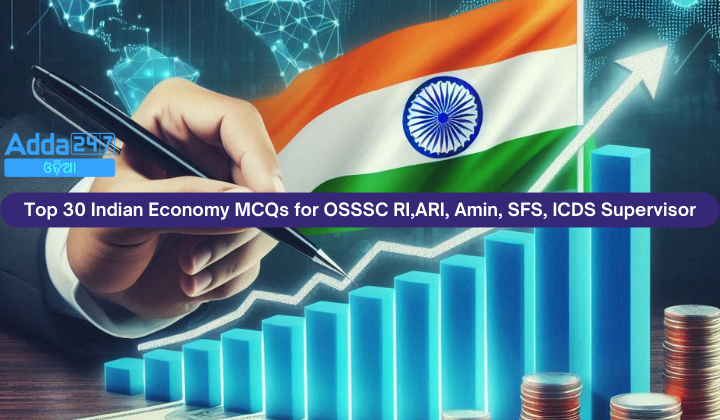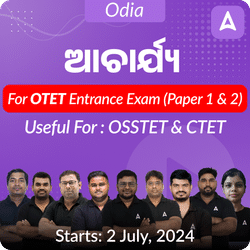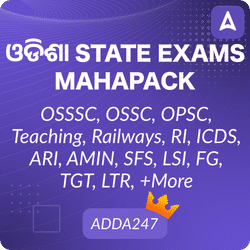Preparing for the OSSSC RI, ARI, Amin, SFS, and ICDS Supervisor exams requires a solid understanding of the Indian economy. These competitive exams often feature questions on economic concepts, policies, and current trends. A focused study of the top 30 multiple-choice questions (MCQs) can significantly enhance your readiness. These questions cover critical topics such as GDP growth, inflation, fiscal policy, banking reforms, and trade. They are tailored to align with the exam pattern, helping candidates gain a comprehensive overview and practice efficiently for their upcoming assessments.
Top 30 Indian Economy MCQs for OSSSC RI,ARI, Amin, SFS, ICDS Supervisor
- Which of the following statements is correct about British rule in India?
(a) The literacy rate was high during the British rule in India
(b) The infant mortality rate was high during the British rule in India
(c) The life expectancy rate was high during the British rule in India
(d) The female literacy rate was high during the British rule in India
Ans. b - What was the policy of British rulers in India for industrialisation?
(a) The British rulers wanted to make India an importer of both primary and finished goods
(b) The British rulers wanted to make India an exporter of both primary and finished goods
(c) The British rulers wanted to make India an importer of primary goods from Britain and an exporter of finished goods to Britain
(d) The British rulers wanted to make India an exporter of primary goods to Britain and an importer of finished goods from Britain
Ans. d - Which of the following statements is true about the occupational structure of the Indian economy during British rule?
(a) The occupational structure of the Indian economy during the British rule was stagnant
(b) The occupational structure of the Indian economy during the British rule was underdeveloped
(c) The occupational structure of the Indian economy during the British rule was both stagnant and underdeveloped
(d) The occupational structure of the Indian economy during British rule was developed
Ans. c - What was one of the major contributions of the Britishers to the Indian economy?
(a) The British rule in India saw the construction of several all-weather roads
(b) The British rule in India saw the introduction of the railway network
(c) The British rule in India saw the development of the inland trade and sea lanes
(d) All of the above
Ans. b - Which of the following was the main interest of the zamindar during the British rule in India?
(a) The main interest of the zamindar was to produce cash crops
(b) The main interest of the zamindar was to collect rent from the farmers
(c) The main interest of the zamindar was to improve the condition of the agricultural sector
(d) The main interest of the zamindar was to produce food crops
Ans. b - Which of the following statements is true about the industrial sector in the Indian economy during the British rule?
(a) India faced an acute shortage of goods that were made within the country
(b) The growth rate for the industrial sector in India was minimal
(c) India was reduced to being an exporter of raw materials
(d) There was a huge increase in cheap imports of goods in India which were manufactured in Britain
Ans. a - Which of the following statements reflects the condition of the agricultural sector in India during British rule?
(a) The agricultural sector experienced huge stagnation and deterioration because of the drain of India’s wealth
(b) The agricultural sector experienced huge stagnation and deterioration because of the land tenure system
(c) The agricultural sector experienced huge stagnation and deterioration because of the decline of handicrafts
(d) None of the above
Ans. b - Which of the following was the main reason for decline in the handicrafts sector during the British rule in India?
(a) New patterns of the demand for handicrafts
(b) The tariff policy followed by the British
(c) The competition in the sector due to man-made machines
(d) All of the above
Ans. d - Which of the following sectors was the major contributor to the Gross Domestic Product (GDP) during the British rule in India?
(a) Primary sector
(b) Secondary sector
(c) Tertiary sector
(d) None of the above
Ans. a - Which of the following statements is an accurate description of the Indian economy on the eve of independence?
(a) India was a net exporter of capital goods
(b) India was a net exporter of primary products
(c) India was a net exporter of industrial products
(d) India was a net exporter of agricultural goods
Ans. b - In which year were the details about the population in British India collected for the first time?
(a) 1881
(b) 1891
(c) 1871
(d) None of the above
Ans. c - Which of the following industries were operating in the Indian economy on the eve of its independence?
(a) Sugar, paper and cement industries
(b) Iron and steel industries
(c) Jute textile and cotton industries
(d) All of the above
Ans. d - Which of the following statements correctly reflects the demographic profile of India on the eve of its independence?
(a) India had an average life expectancy of 63 years
(b) Both the birth rate and death rate in India were very low
(c) The overall levels of literacy in India was even less than 16 percent
(d) The infant mortality rate in India was just around 70 per every thousand live births
Ans. c - Which of the following services was totally inadequate during British rule in India?
(a) Law and order, railways and ports
(b) Postal services
(c) Railways and ports
(d) None of the above
Ans. b - In which year was India’s first official census survey undertaken?
(a) 1881
(b) 1850
(c) 1891
(d) None of the above
Ans. a - When we produce a good by exploiting natural resources, it is called _______.
A. Primary sector
B. Service sector
C. Public sector
D. Tertiary sector
Ans. A: Primary sector - Name one type of classification of the economy.
A. Urban Rural
B. Public/Private
C. State/National
D. Urban
Ans. B: Public/Private - Name one functioning activity of the Tertiary sector.
A. This sector gradually became associated with different kinds of industries.
B. Activities in which natural products are changed into other forms through ways of manufacturing.
C. Produce a good by exploiting natural resources.
D. Goods that are produced would need to be transported by trucks or trains and then sold in wholesale and retail shops.
Ans. D: Goods that are produced would need to be transported by trucks or trains and then sold in wholesale and retail shops. - Not every good (or service) that is produced and sold needs to be counted. It makes sense only to include the ______ to get the total production.
A. Final goods and services.
B. Adding up the actual numbers of goods.
C. Goods and services in the three sectors.
D. Values of goods and services in production.
Ans. A: Final goods and services - The task of measuring GDP is undertaken by the _______.
A. State government
B. Provincial government
C. All of the options are correct
D. Central government
Ans. D: Central government - Which of the following is NOT true about indirect tax?
(a) Wealth tax is direct tax.
(b) It is imposed by the central government but collected by the state government and handed over to central govt.
(c) In the budget of 2016-17, income tax collections was more than non tax revenue.
(d) In the budget of 2016-17, income tax collection was 14% of total revenue of the central government.
Ans. b - Which bank takes care of agriculture & rural finance?
(a) IDBI
(b) IFC
(c) RBI
(d) NABARD
Ans. d - What is CRR?
(a) The rate at which commercial banks borrow money from the Reserve Bank of India.
(b) The rate at which RBI borrows money from the commercial banks.
(c) It’s a rate at which RBI decides the sale and purchase of capital assets with foreign banks.
(d) It’s a proportion of cash that commercial banks have to deposit with the RBI.
Ans. d - Who imposes corporation tax in India?
(a) State govt.
(b) Central govt.
(c) State and central both
(d) Local govt.
Ans. b - Dunkel draft is related to ………
(a) Associated with Uruguay round
(b) Related to atomic treaty among nations
(c) Related to super 301
(d) Related to check drug trade
Ans. a - Who designed the symbol of Indian rupee?
(a) Rakesh Kumar
(b) Udit Raj
(c) D. Uday Kumar
(d) Dr. Raj Kumar
Ans. c - Who had given the concept of zero-based budgeting?
(a) Peter Drucker
(b) Peter Pyhrr
(c) Jagdish Bhagwati
(d) None of these
Ans. b - Who develops and updates Global Hunger Index?
(a) UNICEF
(b) WTO
(c) FAO
(d) International Food Policy Research Institute
Ans. d - ‘ECOMARK’ a symbol is related to ……
(a) Agricultural goods
(b) Manufacturing goods
(c) Goods of best quality
(d) Goods safe for environment
Ans. d - What kind of convertibility of currency is permitted in India?
(a) Capital account
(b) Current account
(c) Both a & b
(d) Partial in both a & b
Ans. c










